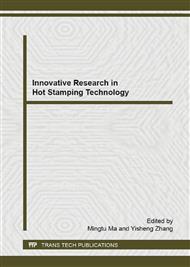p.37
p.42
p.47
p.55
p.59
p.65
p.69
p.73
p.78
A Study on High Speed Tension Property of C-Grade Bullet Proof Steel Plate
Abstract:
In this paper, the high speed tension experiments have been performed on ultra high strength bullet proof steel. The samples were cut from the bullet proof steel plate after hard-module quenching with thickness of 3.7 mm. The mechanical properties at strain rates of 0.001 s-1, 0.01 s-1, 0.1 s-1 and 1 s-1 were carried out on MTS810, while those at higher strain rates of 200 s-1, 500s-1 and 1000s-1 were tested on HTM5020 high speed tension tester and Hopkinson bar. The data from the high-speed tension experiments were fitted via Johnson-Cook constitutive equation, and the fracture surface of each sample was analyzed by SEM. The results indicate that, the shoot-resistance capability of bullet proof steel is closely related to its strength, thickness and flow behaviors under high strain rate. The shoot-resistance will be improved in the case of higher strength and better matching between strength and elongation. The Johnson-Cook equation fitted via experimental data provides fundament to numerical simulation. With the increase of strain rate, the size and depth of dimple trend to decrease and the depth of dimple changes less in steel with lower strength and higher elongation. The SEM analysis of fracture is benefit for further understanding of deformation and fracture mode under high strain rate.
Info:
Periodical:
Pages:
59-64
Citation:
Online since:
December 2014
Authors:
Price:
Сopyright:
© 2015 Trans Tech Publications Ltd. All Rights Reserved
Share:
Citation:


